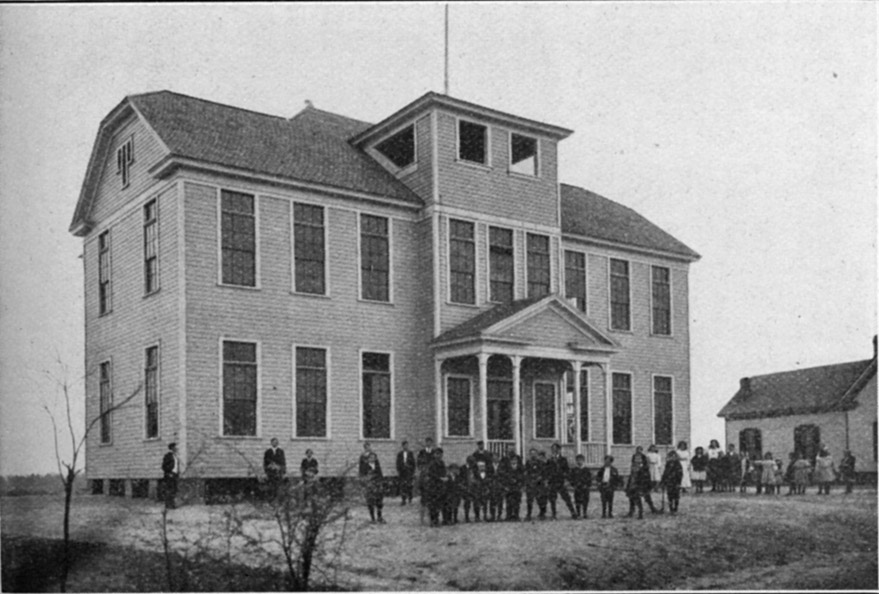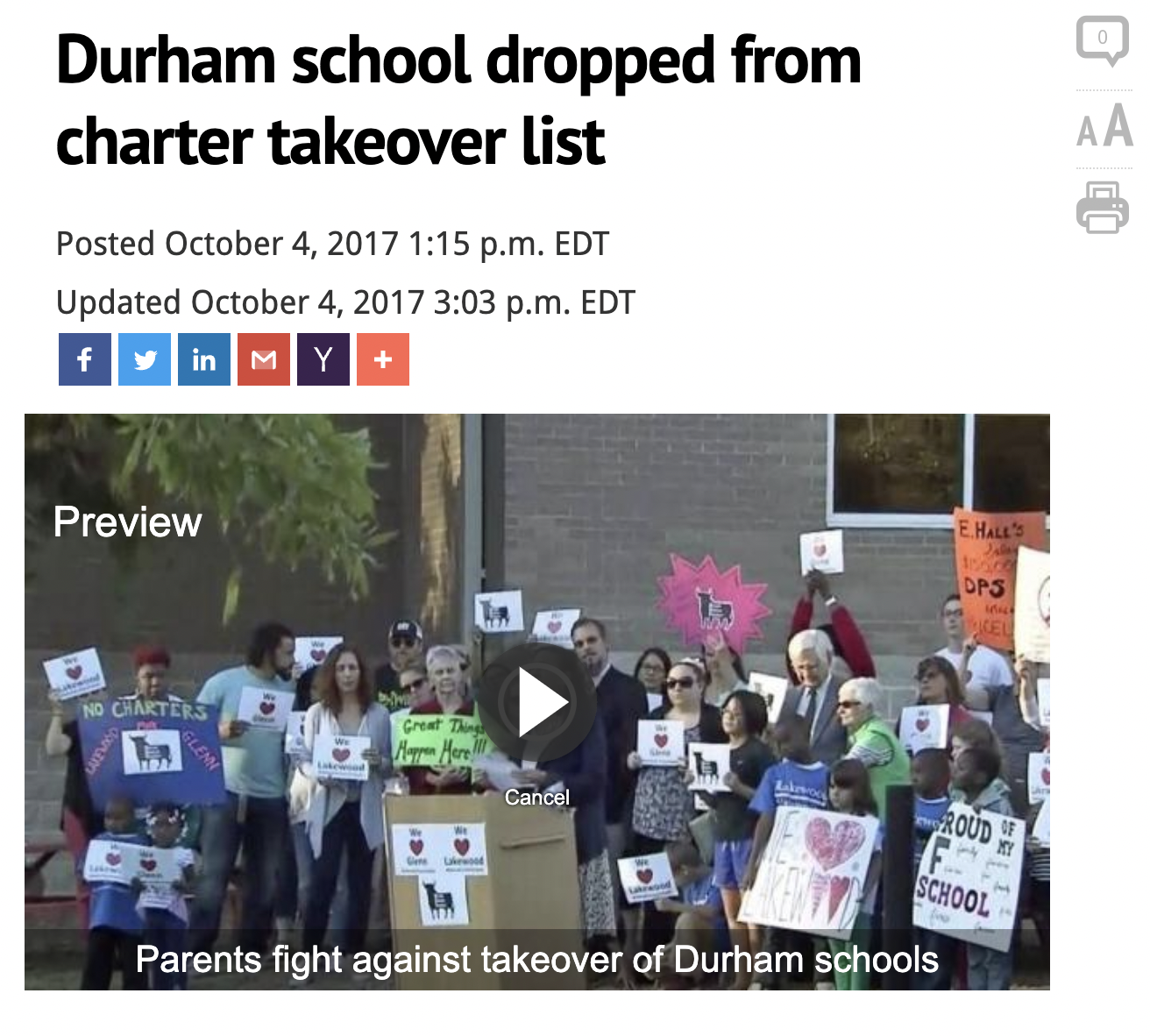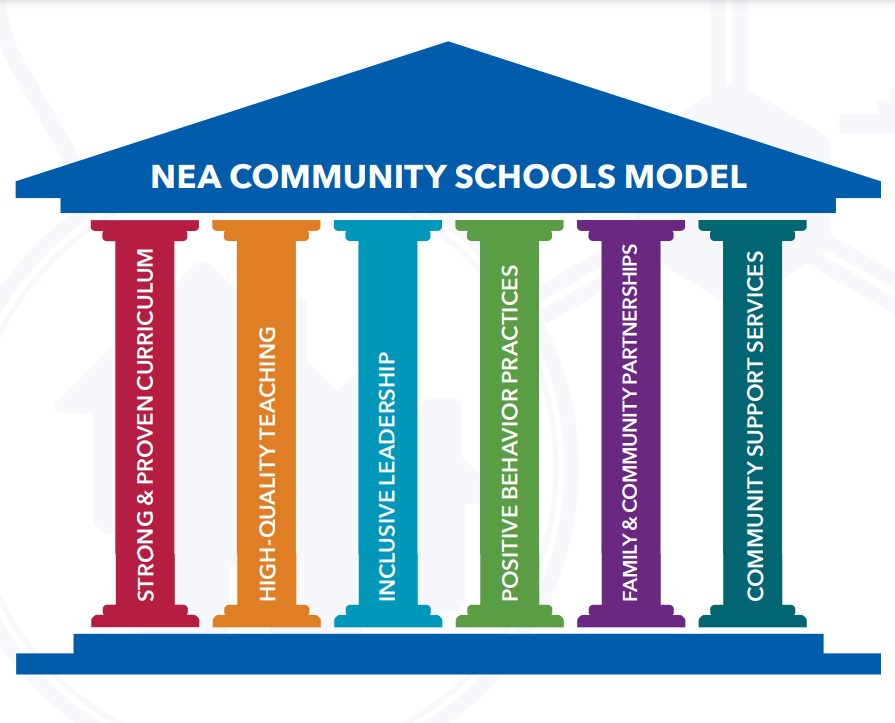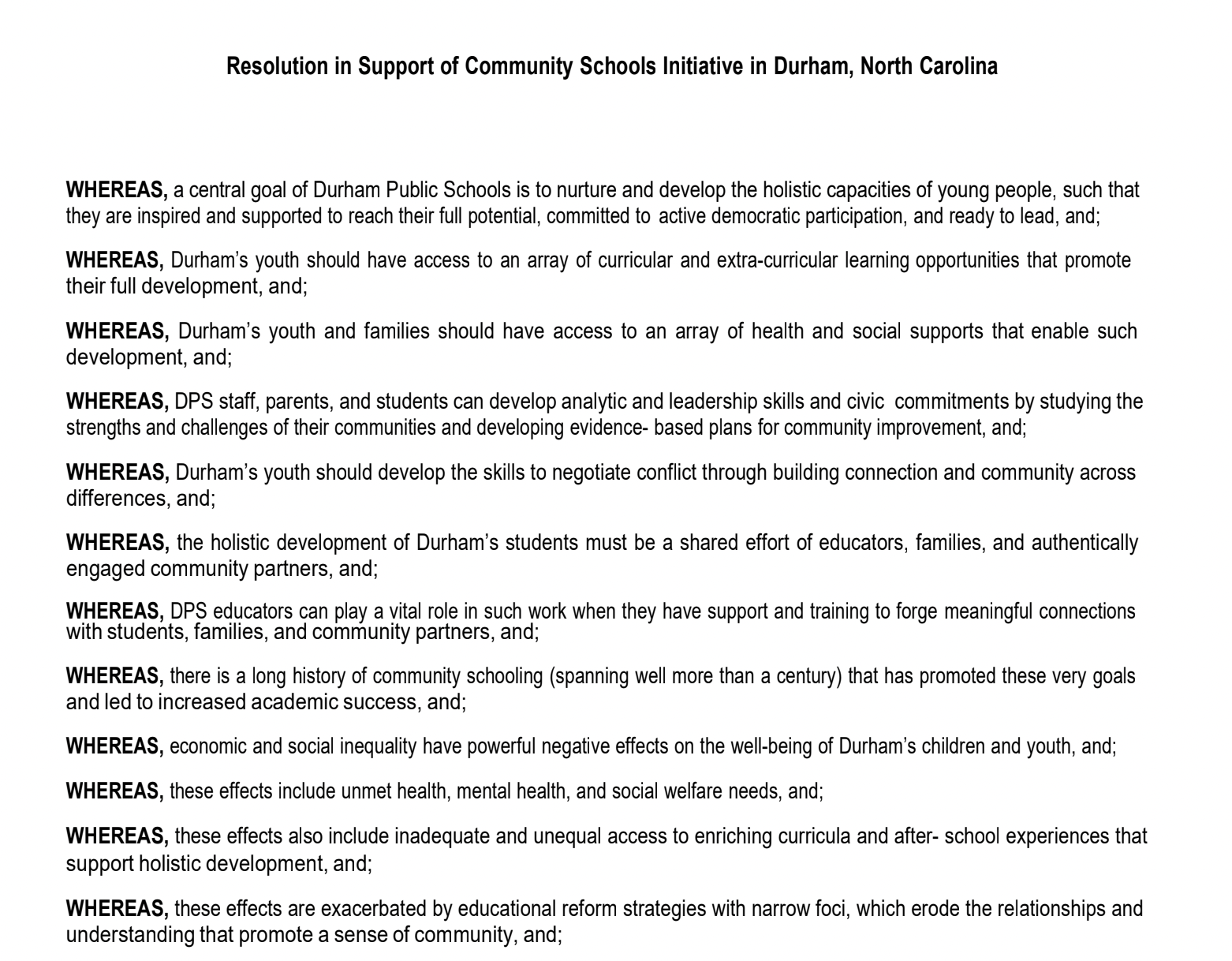Lakewood Elementary School
Community Organizing, Inclusive Leadership and Trust

Introduction
Anna Grant and James Hopkins formally met in the late Fall of 2018. James, a newly appointed principal, and Anna Grant, a former labor organizer, sat down during the summer of 2022 to discuss their relationship during the formative years of piloting the community schools approach at Lakewood Elementary School in Durham, NC. The conversation was cathartic; it gave both practitioners a unique opportunity to reflect on their intimate relationship as community school coordinator and principal, and on Lakewood Elementary School’s community schools journey.
Lakewood Elementary School was established in 1910, and later moved to its current location just a few blocks away in 1962. Today, the student population (the school serves approximately 368 students, grades K-5) reflects the rich diversity of its surrounding neighborhood. The racial demographics of the school are 4.9% Asian, 48.9% Hispanic, 26.6% Black, 12.9% White, and 7.6% Multiracial. Anna and James discussed how this wasn’t always the case with many students opting to attend schools outside of the neighborhood. As school choice became more prevalent in the early 2000’s, many families chose charter schools and private schools over Durham Public Schools. This decrease in enrollment had direct impacts on the funding allocated for schools like Lakewood. As James and Anna discussed, it also left staff morale at an all-time low.

James and Anna no longer work side-by-side at Lakewood Elementary School. Anna is now an organizer with the National Education Association (NEA) Strategic Campaign Institute for Community Schools and James recently became the inaugural principal at the newly opened Lyon Farm Elementary School in Durham. Anna and James discussed some of their early challenges in aligning around inclusive and horizontal leadership practices, and their deep commitment to extending the lessons learned into their future endeavors. The conversation offers honest and heartfelt insight into the power of community organizing, inclusive leadership, trust, and humility–all foundational practices of the community schools strategy.
The conversation offers honest and heartfelt insight into the power of community organizing, inclusive leadership, trust, and humility–all foundational practices of the community schools strategy.
It’s not Magic, It’s Community Organizing
After just becoming principal at Lakewood Elementary School for the 2017-2018 academic year, James received news that the school was in danger of being taken over by North Carolina’s Innovative School District (ISD), and out of the hands of the publicly elected Durham Public Schools Board of Education. The school landed on the ISD list due to low student performance on standardized tests, and failure to meet expected growth. Alongside teachers, students, caregivers, and community members, James and Durham Public Public Schools (DPS) were able to fend off the ISD and remain autonomous over Lakewood. Whereas James was incredibly relieved and encouraged by the impassioned support demonstrated by the Durham community, he also felt extraordinary stress about the responsibility that was bestowed upon him to turn Lakewood around. He found himself grappling with how to mobilize his school staff who were discouraged by the impending takeover.
He found himself grappling with how to mobilize his school staff who were discouraged by the impending takeover.

Only a few months into his first semester at Lakewood, he was approached by Anna Grant. While Anna would eventually serve as Lakewood’s community school coordinator, she initially came to the community as a recent hire of the NEA local affiliate, the Durham Association of Educators (DAE). Anna’s role was to campaign for community schools as a strategy to defend and transform Lakewood Elementary School. Anna learned through local organizing with DAE that James had a reputation for being an inclusive leader. She was optimistic that his desire to bring in the voices of students, families and community members could serve as a powerful foundation for the approach. For Anna, the first meeting didn’t exactly go as planned. James was skeptical because like many educators around the country, James was no stranger to new initiatives in education that rarely came with new resources.
Throughout the course of the next few meetings, James found himself growing more intrigued around the core ask that Anna was making, which was to allow her to organize Lakewood Elementary School caregivers and staff to learn and get excited about the community schools approach. Anna recalls this particular moment in their relationship:
What we asked of you was to let me organize in the school. I had previously been a family liaison for DPS, so I had been a school employee. But at that time, I was an employee of the Union and I was asking to come into the school, and organize staff and parents. By ‘organize,’ I mean, win them over, get them excited, get them inspired, engage them, hear their fears and doubts around this community school model. And I was sort of, fast track, trying to learn as much as I could about the model as quickly as possible, and this school and the other schools.
James learned very quickly that Anna was a highly skilled organizer. In particular, he recalled her refreshing orientation towards leadership development. Anna was able to convince James of the humbling reality that there could be organic leaders in the building that would be more successful in increasing staff morale than him. The two were able to create a power-map of the building in an effort to identify which staff members would be most enthusiastic about the community schools approach. James lit up when remembering the first time he saw Anna engaging with the school staff:
She was a powerhouse, and more specifically, I think it was the one-on-ones you had with people. It wasn’t some, ‘Hey, let me speak at a staff meeting and tell you about this thing’. You had this massive notebook of all these people that you’ve done one-on-ones with. And you have this map. And we talked about the map.
The one-on-ones with staff allowed Anna and James to further identify organic leaders in the building, while also allowing them to illustrate how the six pillars of NEA Community Schools could respond to the concerns voiced by the school staff. Additionally, Anna created a FAQ that helped dispel myths about community schools that commonly came up in her conversations. She was able to clarify misconceptions that community schools are school-takeover models, separated from the rest of DPS, or more work for educators. After only two months of conversations, Anna and James made a strategic decision to codify the support for the community schools approach through an internal vote at Lakewood. Anna and James reflected on their election goal for assessing whether they had the necessary shared ownership to move forward with implementation:
The two laughed when remembering James’ competitive spirit and his lingering disappointment that they didn’t reach 100%. The election served as a profound step in the process to winning community schooling for Lakewood. As Anna was organizing the building through her informational campaign, she was simultaneously working outside the building to ensure that there would be support from the school district to fund a portion of the pilot. Anna, James, and 97% of the Lakewood Elementary School staff were elated to learn that their organizing earned the support of the Durham Public Schools Board of Education through the “Resolution in Support of Community Schools Initiative ” signed on March 8, 2018. The resolution confirmed DPS’s commitment to community schools through an endorsement to hire community school coordinators at four pilot schools. Anna transitioned from NEA organizer to the director of community schools.
Inclusive Leadership
In their efforts to foster a culture of inclusive leadership, both James and Anna acknowledged how difficult it is for a principal to lead a school when the staff does not fully understand top-down decisions or have input on administrative choices that affect them. The trust that James and Anna built over time gave James a foundation from which he could grow as a leader. James reflected on how much he had to change as he began to share decision-making with his staff:
I’m a much different person now, right? The first year was hard. I was trying to find my voice as a leader. And then feeling very much like I have to step down from finding my voice and lending my voice and spreading my voice and not knowing where that was going to end. It was hard because I wasn’t in complete control. That was scary. But once I realized, [that] when you have someone there to coach you on, ‘You’re doing the right thing and this is why’ or ‘you’re doing the right thing, and yes, it’s tough. Push through. There’s fruit at the end,’ it made it less difficult.
Anna made it clear that James’ willingness to share leadership was exemplary considering the pressure that he faced from the district as a first-time principal and as a leader of a school where low staff morale was as much an issue as the academic performance of the students. Anna acknowledged the difficulty that James initially faced. “I knew you were scared, I knew why you were scared. So I really wanted you to feel that my goal was for you to be as successful as possible as a leader.”
I knew you were scared, I knew why you were scared. So I really wanted you to feel that my goal was for you to be as successful as possible as a leader.
As James and Anna began to better understand each other’s styles, they created a united vision for expanding their team. The newly secured funding earned through the resolution allowed them to hire a full-time community school coordinator. James and Anna leveraged the momentum and relationships that they had worked so hard to create during the campaign phase in order to create a search committee that was inclusive of all the partners in the school. As James recalls, “We had parents on the committee, something I had never experienced before.” Anna added, “We are going to practice democracy because people need to feel this and understand it.”
The search committee was overjoyed after identifying their first community school coordinator, who unfortunately did not remain in that position. While acting as director for community schools, Anna eventually filled the vacancy of the coordinator role at Lakewood. Wearing both hats challenged her bandwidth, but the dynamic relationship that she had with James became a model for other principals and coordinators around the district. Anna became an integral part of the school improvement team (SIT), and was an invaluable asset because of her inside/outside perspective with families and teachers, as well as with James and the rest of the SIT. It became imperative that Anna be able to extend leadership opportunities on the SIT with classroom teachers and caregivers that she had spent months building relationships with.
We are going to practice democracy because people need to feel this and understand it.
Trust and Humility
The school conducted a comprehensive asset and needs assessment during the 2018-2019 academic year with the goal of engaging a majority of staff, families, and students. James and Anna were aligned around the methodical process of collecting data from all of the school constituents, and also realized that they didn’t want to lose the momentum that they had from the previous semester. People wanted to see quick results, and the SIT team needed to identify where they could earn early wins. One of the team’s earliest wins was increased participation of parents. Within the first months of the spring semester, Lakewood saw a 460% increase in PTA meeting attendance and a 1,025% increase in participation from BIPOC families compared to the previous academic year.
The assets and needs assessment process continued to reveal challenges around how the school’s constituency experienced James’ leadership. James grappled with external pressures from outside the building, and internal ones as well. The trusting relationship he had developed with Anna, first as an organizer and then as a director and coordinator, became essential as he attempted to meet the needs of his Lakewood family. Anna’s office at Lakewood became a safe space for school staff and caregivers to share concerns. Anna was able to synthesize their concerns and strategically relay the biggest priorities to James. James expressed his appreciation for Anna and her ability to give him insight into the staff and caregiver perspective:
You absorbed a lot of that stuff. And then filtered it to me in such a way that sometimes was hard. That staff feedback survey was hard for me to look at at the time. You helped me filter it. You said, ‘I understand you have feelings about that. But that’s not the question here. The big picture was, this is how we should do it differently to impact the school’. I had to get out of my feelings, because there were some things that were shared that were humbling.
James’ humility became one of his biggest assets as the leader of Lakewood. Staff and caregivers were comforted by the renewed collective leadership style displayed by the SIT over the course of the academic year. The trust that James and Anna were able to garner became vital as they completed synthesizing results from the assets and needs assessment, and transitioning to the next phase of the process. As acute needs emerged out of the assets and needs assessment, school staff self-organized around topics closest to their interests. Goal teams were formed and staff began the continuous improvement science process.
The Journey Continues
The goal teams and continuous improvement science journey is still underway at Lakewood Elementary School and early results are promising. The path to transformation did not involve a magic wand or quick fixes; it involved a deep commitment to organizing and sharing leadership. The commitment that Anna and James made to one another, and to the Lakewood Elementary School community, continues to bear fruit even in their absence.

* Student growth is the amount of academic progress the student has made over the course of a grade or class. Student proficiency is whether or not students have scored at a level that indicates that they consistently demonstrate mastery of content standards. The State uses multiple assessments and processes to measure student learning including end-of-grade or course assessments, CTE state assessments, NC Final Exams, and K-3 Checkpoints.
The path to transformation did not involve a magic wand or quick fixes; it involved a deep commitment to organizing and sharing leadership.
Five years into its community school journey, Lakewood Elementary’s first PTA meeting of the 2022-23 school year was called to order by new PTA president Shereese Daniels. Shereese is also a new community school parent organizer, working part-time for the Durham Public School Foundation, the lead agency of the community schools partnership. She introduced new Lakewood principal, Jeri Jackson, and new Lakewood community schools coordinator, Charryse Fredrick Omari. While addressing the crowded cafeteria, this new team set an expectation for parents to engage in the shared leadership practices that define the Lakewood Elementary experience. As in the past, the smell of pizza and the sound of interpretation filled the air because even during and after a pandemic, the organizing didn’t stop.
About the Authors
Alec Greenwald is currently the Associate Director for Strategic and Special Initiatives to the Dean of Academic Affairs in the Trinity College of Arts and Sciences at Duke University. He has been a public-school teacher, parent, researcher and activist for almost 20 years. Alec has helped to lead multiple interdisciplinary research initiatives with Duke and North Carolina Central University students through the Durham University-Assisted Community Schools Research Collective.
Xavier Cason works for the Durham Public Schools Foundation as Director of Community Schools. A retired educator, Xavier formally served on the Durham Public Schools Board of Education and is currently a Ph.D. student at NC State University studying Education Evaluation and Policy Analysis. Xavier serves on several boards related to early education and community engagement, and is a team lead with the Durham University-Assisted Community Schools Research Collective.
James I. Hopkins has been a public educator for the past 20 years. In his current role as principal of Lyons Farm Elementary School, he has been eager to ensure the Lyon family–descendants from slaves, history is told and embedded into the culture of the school and community. He has taught and has been an administrator at the high school and middle levels before moving to elementary school. His core values are gratitude, feedback, and collaboration.
Anna Grant is a coach with the NEA Strategic Campaign Institute for Community Schools. She was trained as an organizer in Unite HERE Local 274 in Philadelphia and has been working in and with public schools since 2016 when she moved home to Durham. The former Community School Coordinator at Lakewood Elementary, she is now obsessed with the question of how to recruit, train and sustain transformational leaders at an ever larger scale.
10 MINUTE READ
This case introduces you to a particular community school journey, which is intended to help you think about your own journey to create, develop, or support community schools. There are resources in the sidebar to dig deeper on particular topics and a discussion protocol designed to be used in a faculty meeting or professional development workshop. If you use these resources and have any feedback that might strengthen future school cases, please let us know.
TABLE OF CONTENTS
REPORT LINKS
RESOURCES
To explore the school’s history and experience further, check out these videos, reports, lesson plans, magazine articles, and more. These resources are curated to speak to different audiences, including teachers, researchers, policymakers, and the general public.
CITATION
Greenwald, A., Cason, X.L. (2022). Lakewood Elementary School: Community Organizing, Inclusive Leadership and Trust. Community Schooling, Issue 3, Fall 2022.
ACKNOWLEDGEMENTS
We would like to express our deepest gratitude to the entire Lakewood Elementary School community for your belief in the Bull City Community School Partnership, and for your dedication to your students and to one another. We would like to thank the Durham Association of Educators, the National Association of Educators, the Durham Public Schools Foundation, Durham Public Schools, and the entire Durham community for your steadfast commitment to defending and transforming our public schools. #InThisTogether
REVIEWERS
This report benefited from the insights and expertise of two external reviewers. We are extremely grateful to Barnett Berry, a research professor at the University of South Carolina and Senior Director for Policy & Innovation in the College of Education, and to Donnie Hale, Regional Deputy Director, Southern Regional TAC for the Institute for Educational Leadership. Their keen insights and knowledge of community schools enriched the study of Lakewood Elementary School.




